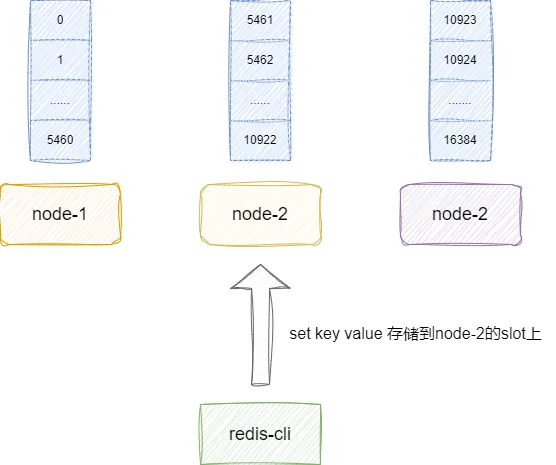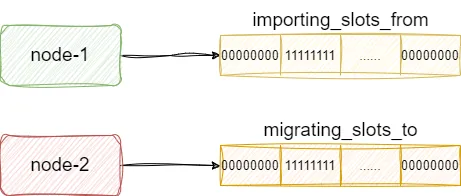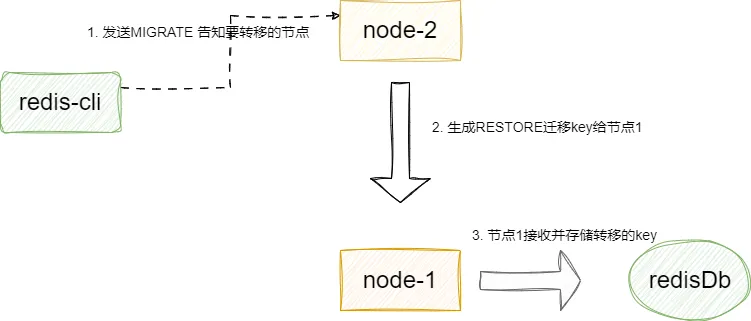聊聊 Redis 集群數(shù)據(jù)遷移

詳解redis cluster數(shù)據(jù)遷移過(guò)程
節(jié)點(diǎn)基本結(jié)構(gòu)定義
redis集群提供16384個(gè)slot,我們可以按需分配給節(jié)點(diǎn)上,后續(xù)進(jìn)行鍵值對(duì)存儲(chǔ)時(shí),我們就可以按照算法將鍵值對(duì)存到對(duì)應(yīng)slot上的redis服務(wù)器上:

集群節(jié)點(diǎn)本質(zhì)就是通過(guò)slots這個(gè)數(shù)組記錄當(dāng)前節(jié)點(diǎn)的所管理的情況,這里我們可以看到slots是一個(gè)char 數(shù)組,長(zhǎng)度為REDIS_CLUSTER_SLOTS(16384)除8,這樣做的原因是因?yàn)?
- char占1個(gè)字節(jié),每個(gè)字節(jié)8位。
- 每個(gè)char可以記錄8個(gè)slot的情況,如果是自己的slot則對(duì)應(yīng)char的某一個(gè)位置記錄為1:
我們以node-1為例,因?yàn)樗?fù)責(zé)0-5460的節(jié)點(diǎn),所以它的slots0-5460都為1,對(duì)應(yīng)的圖解如下所示,可以看到筆者這里省略了后半部分,僅僅表示了0-15位置為1:

對(duì)此我們也給出這段redis中節(jié)點(diǎn)的定義,即位于cluster.h中的clusterNode這個(gè)結(jié)構(gòu)體中,可以看slots這段定義:
typedef struct clusterNode {
//......
//記錄集群負(fù)責(zé)的槽,總的為16384
unsigned char slots[REDIS_CLUSTER_SLOTS/8];
//......
}設(shè)置slot后續(xù)節(jié)點(diǎn)走向
以本文示例為例,我們希望后續(xù)節(jié)點(diǎn)2的數(shù)據(jù)全部存到節(jié)點(diǎn)1中,那么我們首先需要鍵入如下兩條配置:
# 在節(jié)點(diǎn)1上執(zhí)行,將節(jié)點(diǎn)2數(shù)據(jù)導(dǎo)入到節(jié)點(diǎn)1上
CLUSTER SETSLOT 3 IMPORTING node2
# 在節(jié)點(diǎn)2上執(zhí)行,將自己的數(shù)據(jù)遷移到節(jié)點(diǎn)1
CLUSTER SETSLOT 3 MIGRATING node1這兩條指最終都會(huì)被各自的服務(wù)端解析,并調(diào)用clusterCommand執(zhí)行,我們以節(jié)點(diǎn)1導(dǎo)入為例,假設(shè)我們執(zhí)行clusterCommand解析到setslot 關(guān)鍵字和importing關(guān)鍵字,即知曉要導(dǎo)入其他節(jié)點(diǎn)的數(shù)據(jù)。對(duì)應(yīng)的節(jié)點(diǎn)1就會(huì)通過(guò)importing_slots_from數(shù)組標(biāo)記自己將導(dǎo)入這個(gè)slot的數(shù)據(jù),而節(jié)點(diǎn)2也會(huì)通過(guò)migrating_slots_to數(shù)組標(biāo)記自己要將數(shù)據(jù)導(dǎo)出給其他節(jié)點(diǎn)的slot:

對(duì)此我們給出clusterCommand的執(zhí)行流程,可以看到該函數(shù)解析出migrating或者importing關(guān)鍵字時(shí)就會(huì)將對(duì)的migrating_slots_to或者importing_slots_from數(shù)組對(duì)應(yīng)slot位置的索引位置設(shè)置為當(dāng)前上述命令傳入的node id:
void clusterCommand(redisClient *c) {
//......
if (!strcasecmp(c->argv[3]->ptr,"migrating") && c->argc == 5) {//處理遷出的邏輯
//看看自己是否有遷出的slot,沒(méi)有則報(bào)錯(cuò)
if (server.cluster->slots[slot] != myself) {
addReplyErrorFormat(c,"I'm not the owner of hash slot %u",slot);
return;
}
//查看自己是否知曉這個(gè)node id,如果沒(méi)有則報(bào)錯(cuò)
if ((n = clusterLookupNode(c->argv[4]->ptr)) == NULL) {
addReplyErrorFormat(c,"I don't know about node %s",
(char*)c->argv[4]->ptr);
return;
}
//標(biāo)記遷出到slot為傳入的node
server.cluster->migrating_slots_to[slot] = n;
} else if (!strcasecmp(c->argv[3]->ptr,"importing") && c->argc == 5) {//處理遷入的邏輯
//查看遷入的slot是否已經(jīng)配置,如果有則報(bào)錯(cuò)
if (server.cluster->slots[slot] == myself) {
addReplyErrorFormat(c,
"I'm already the owner of hash slot %u",slot);
return;
}
//查看自己是否知曉要遷入數(shù)據(jù)的node的信息,如果不知道則報(bào)錯(cuò)
if ((n = clusterLookupNode(c->argv[4]->ptr)) == NULL) {
addReplyErrorFormat(c,"I don't know about node %s",
(char*)c->argv[3]->ptr);
return;
}
//標(biāo)記遷入slot位置為傳入的nodeid
server.cluster->importing_slots_from[slot] = n;
} //......
}后續(xù)的我們假設(shè)還是將set key value請(qǐng)求發(fā)送到節(jié)點(diǎn)2,因?yàn)樯鲜雒畹脑颍?jié)點(diǎn)會(huì)返回move/ask告知客戶(hù)端這個(gè)鍵值對(duì)現(xiàn)在要存到節(jié)點(diǎn)1上。對(duì)應(yīng)節(jié)點(diǎn)1收到這個(gè)key請(qǐng)求時(shí),通過(guò)key計(jì)算得slot正是自己,它就會(huì)將這個(gè)鍵值對(duì)存儲(chǔ)到自己的數(shù)據(jù)庫(kù)中:

這里我們以節(jié)點(diǎn)1的角度查看這個(gè)問(wèn)題,當(dāng)客戶(hù)端收到move指令后,繼續(xù)向節(jié)點(diǎn)1發(fā)送指令,節(jié)點(diǎn)1通過(guò)收到指令調(diào)用processCommand,其內(nèi)部調(diào)用getNodeByQuery獲取當(dāng)前key對(duì)應(yīng)的slot,發(fā)現(xiàn)是自己則直接存儲(chǔ)數(shù)據(jù)到當(dāng)前節(jié)點(diǎn)的內(nèi)存數(shù)據(jù)庫(kù)中:
int processCommand(redisClient *c) {
//......
//如果開(kāi)啟了集群模式,且發(fā)送者不是master且參數(shù)帶key則進(jìn)入邏輯
if (server.cluster_enabled &&
!(c->flags & REDIS_MASTER) &&
!(c->flags & REDIS_LUA_CLIENT &&
server.lua_caller->flags & REDIS_MASTER) &&
!(c->cmd->getkeys_proc == NULL && c->cmd->firstkey == 0))
{
int hashslot;
if (server.cluster->state != REDIS_CLUSTER_OK) {
//......
} else {
int error_code;
//查找鍵值對(duì)對(duì)應(yīng)的slot和這個(gè)slot負(fù)責(zé)的節(jié)點(diǎn)
clusterNode *n = getNodeByQuery(c,c->cmd,c->argv,c->argc,&hashslot,&error_code);
//如果為空且或者非自己,則轉(zhuǎn)交出去給別人處理
if (n == NULL || n != server.cluster->myself) {
flagTransaction(c);
clusterRedirectClient(c,n,hashslot,error_code);
return REDIS_OK;
}
}
}
//......
//將鍵值對(duì)存儲(chǔ)到當(dāng)前數(shù)據(jù)庫(kù)中
}我們以節(jié)點(diǎn)的視角再次直接步入getNodeByQuery查看這段邏輯,可以看到其內(nèi)部會(huì)基于key計(jì)算slot然后將得到對(duì)應(yīng)的node,如果發(fā)現(xiàn)這個(gè)node是自己且屬于importing_slots_from,即說(shuō)明是客戶(hù)端通過(guò)move或者ask請(qǐng)求找到自己的,則進(jìn)行進(jìn)一步是否是多條指令執(zhí)行且存在key找不到存儲(chǔ)位置的情況,若存在則返回空,反之都是直接返回當(dāng)前節(jié)點(diǎn)信息,即node2的新數(shù)據(jù)直接遷移過(guò)來(lái):
clusterNode *getNodeByQuery(redisClient *c, struct redisCommand *cmd, robj **argv, int argc, int *hashslot, int *error_code) {
//......
//遍歷命令
for (i = 0; i < ms->count; i++) {
//.....
//獲取指令、參數(shù)個(gè)數(shù)、參數(shù)
mcmd = ms->commands[i].cmd;
margc = ms->commands[i].argc;
margv = ms->commands[i].argv;
//解析出key以及個(gè)數(shù)
keyindex = getKeysFromCommand(mcmd,margv,margc,&numkeys);
for (j = 0; j < numkeys; j++) {
//拿到key
robj *thiskey = margv[keyindex[j]];
//計(jì)算slot
int thisslot = keyHashSlot((char*)thiskey->ptr,
sdslen(thiskey->ptr));
//.....
//如果就是當(dāng)前節(jié)點(diǎn)正在做遷出或者遷入,則migrating_slot/importing_slot設(shè)置為1
if (n == myself &&
server.cluster->migrating_slots_to[slot] != NULL)
{
migrating_slot = 1;
} else if (server.cluster->importing_slots_from[slot] != NULL) {
importing_slot = 1;
}
} else {
//.....
//.....
}
//.....
}
//如果設(shè)置了導(dǎo)入標(biāo)識(shí)為1且標(biāo)識(shí)為asking則步入這段邏輯,
if (importing_slot &&
(c->flags & REDIS_ASKING || cmd->flags & REDIS_CMD_ASKING))
{ //當(dāng)前指令有多個(gè)key且存在未命中的則返回空,反之返回自己
if (multiple_keys && missing_keys) {
if (error_code) *error_code = REDIS_CLUSTER_REDIR_UNSTABLE;
return NULL;
} else {
return myself;
}
}
//.....
//返回節(jié)點(diǎn)信息以本示例來(lái)說(shuō)就是返回當(dāng)前節(jié)點(diǎn)信息
return n;
}完成節(jié)點(diǎn)遷移
上述操作僅僅針對(duì)新節(jié)點(diǎn)的遷移,對(duì)于舊的節(jié)點(diǎn)我們就需要通過(guò)節(jié)點(diǎn)2鍵入CLUSTER GETKEYSINSLOT slot count要遷移的舊的key的slot,然后通過(guò)MIGRATE host port key dbid timeout [COPY | REPLACE]將數(shù)據(jù)遷移到節(jié)點(diǎn)1上。 這里我們補(bǔ)充一下MIGRATE 中copy和replace的區(qū)別,前者是遇到重復(fù)直接報(bào)錯(cuò),后者是遷移時(shí)直接覆蓋。 最終這條指令回基于要遷移的key而生成一條RESTORE-ASKING key ttl serialized-value [REPLACE] [ABSTTL] [IDLETIME seconds] [FREQ frequency]指令發(fā)送給導(dǎo)入的節(jié)點(diǎn),以本文例子來(lái)說(shuō)就是節(jié)點(diǎn)1:

這里我們給出MIGRATE 指令對(duì)應(yīng)的處理函數(shù)migrateCommand,邏輯和我上文說(shuō)的差不多,基于指令解析出replace或者copy等信息,然后用argv[3]即我們的key得出這個(gè)鍵值對(duì)的信息生成RESTORE指令將鍵值對(duì)轉(zhuǎn)存給節(jié)點(diǎn)1:
/* 命令 MIGRATE host port key dbid timeout [COPY | REPLACE] */
void migrateCommand(redisClient *c) {
//......
//解析拷貝和替代選項(xiàng),前者重復(fù)會(huì)報(bào)錯(cuò)
for (j = 6; j < c->argc; j++) {
if (!strcasecmp(c->argv[j]->ptr,"copy")) {
copy = 1;
} else if (!strcasecmp(c->argv[j]->ptr,"replace")) {
replace = 1;
} else {
addReply(c,shared.syntaxerr);
return;
}
}
//......
//查看要遷移的key是否存在嗎,如果不存則直接報(bào)錯(cuò)返回
if ((o = lookupKeyRead(c->db,c->argv[3])) == NULL) {
addReplySds(c,sdsnew("+NOKEY\r\n"));
return;
}
/* Connect */
//建立socket連接
cs = migrateGetSocket(c,c->argv[1],c->argv[2],timeout);
//......
//cmd初始化一個(gè)buf緩沖區(qū)
rioInitWithBuffer(&cmd,sdsempty());
/* Send the SELECT command if the current DB is not already selected. */
//如果尚未選擇當(dāng)前DB,則發(fā)送SELECT命令。
int select = cs->last_dbid != dbid; /* Should we emit SELECT? */
if (select) {
redisAssertWithInfo(c,NULL,rioWriteBulkCount(&cmd,'*',2));
redisAssertWithInfo(c,NULL,rioWriteBulkString(&cmd,"SELECT",6));
redisAssertWithInfo(c,NULL,rioWriteBulkLongLong(&cmd,dbid));
}
/* Create RESTORE payload and generate the protocol to call the command. */
//獲取key的過(guò)期時(shí)效
expireat = getExpire(c->db,c->argv[3]);
if (expireat != -1) {
ttl = expireat-mstime();
if (ttl < 1) ttl = 1;
}
//集群用RESTORE-ASKING發(fā)送key給目標(biāo)
if (server.cluster_enabled)
redisAssertWithInfo(c,NULL,
rioWriteBulkString(&cmd,"RESTORE-ASKING",14));
else
redisAssertWithInfo(c,NULL,rioWriteBulkString(&cmd,"RESTORE",7));
//填充key和value ttl等
redisAssertWithInfo(c,NULL,sdsEncodedObject(c->argv[3]));
redisAssertWithInfo(c,NULL,rioWriteBulkString(&cmd,c->argv[3]->ptr,
sdslen(c->argv[3]->ptr)));
redisAssertWithInfo(c,NULL,rioWriteBulkLongLong(&cmd,ttl));
//......
//遷移指令字符串寫(xiě)入緩沖區(qū)
redisAssertWithInfo(c,NULL,rioWriteBulkString(&cmd,payload.io.buffer.ptr,
sdslen(payload.io.buffer.ptr)));
//......
//如果是replace發(fā)出 REPLACE
if (replace)
redisAssertWithInfo(c,NULL,rioWriteBulkString(&cmd,"REPLACE",7));
//......
}最后調(diào)整
最后我們只需在節(jié)點(diǎn)1和2都執(zhí)行CLUSTER SETSLOT <SLOT> NODE <NODE ID> 完成slot指派,這指令最終就會(huì)走到clusterCommand中,節(jié)點(diǎn)1和節(jié)點(diǎn)2格子的處理邏輯為:
- 節(jié)點(diǎn)2看看遷移的key是否不存則且migrating_slots_to數(shù)據(jù)不為空,若符合要求說(shuō)明遷移完成但狀態(tài)未修改,直接將migrating_slots_to置空完成指派最后調(diào)整。
- 節(jié)點(diǎn)1查看節(jié)點(diǎn)id是否是自己且importing_slots_from是否有數(shù)據(jù),若有則說(shuō)明節(jié)點(diǎn)導(dǎo)入完成,直接將importing_slots_from置空。
void clusterCommand(redisClient *c) {
//......
else if (!strcasecmp(c->argv[1]->ptr,"setslot") && c->argc >= 4) {//處理setslot指令
//......
else if (!strcasecmp(c->argv[3]->ptr,"node") && c->argc == 5) {
/* CLUSTER SETSLOT <SLOT> NODE <NODE ID> 標(biāo)記最終遷移的節(jié)點(diǎn) */
clusterNode *n = clusterLookupNode(c->argv[4]->ptr);
//......
//如果發(fā)現(xiàn)對(duì)應(yīng)的key為0,且migrating_slots_to不為空,則說(shuō)明遷出完成但狀態(tài)還未修改,節(jié)點(diǎn)2會(huì)將migrating_slots_to設(shè)置為空
if (countKeysInSlot(slot) == 0 &&
server.cluster->migrating_slots_to[slot])
server.cluster->migrating_slots_to[slot] = NULL;
//如果是節(jié)點(diǎn)1則會(huì)看指令的nodeid是否是自己且importing_slots_from是否有數(shù)據(jù),若有則說(shuō)明導(dǎo)入成功直接將importing_slots_from設(shè)置為空
if (n == myself &&
server.cluster->importing_slots_from[slot])
{
//......
server.cluster->importing_slots_from[slot] = NULL;
}
}
//......
}






































